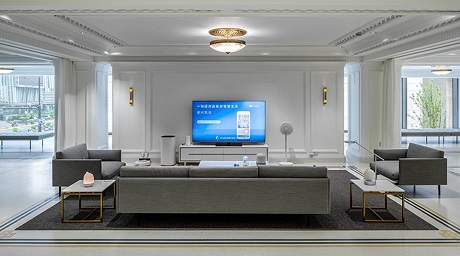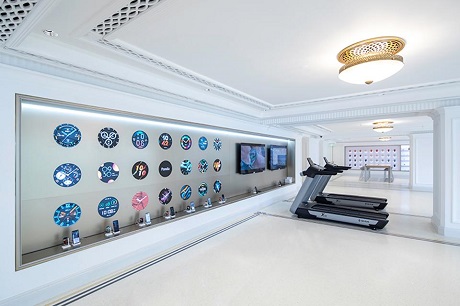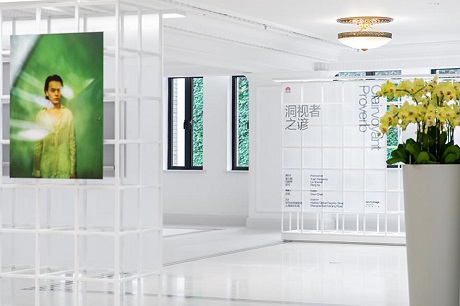 World's largest Huawei flagship store opens on East Nanjing Road, Shanghai HUAWEI
World's largest Huawei flagship store opens on East Nanjing Road, Shanghai HUAWEIWhen Angela Ahrendts joined Apple as head of retail back in 2014, she had brought in her expertise from Burberry and transformed the electronics store with a higher-end feel, elevating its luxury status. Ahrendts and chief design officer Jony Ive turned around its cold stainless-steel store designs into bright, wooden-themed “town squares”—and also planted lots of trees.
Meanwhile, Chinese consumer electronics and smartphone maker Huawei has just opened its doors to its largest flagship in Shanghai amid post-COVID times. The brand currently outranks Apple and is known as the second-largest smartphone maker in the world, tailing right behind Samsung.
Following their first global flagship debut in Shenzhen last year, the Shanghai store is housed in a second-grade art-deco style building, a design erected by British real estate tycoon Silas Aaron Hardoon in 1935 where its original form has been preserved with modern interior elements. Construction of the flagship took a mere six months beginning February this year, during the initial outbreak of the coronavirus, and is said to have cost over $42 million in its build. Formerly, Forever 21 held the same space and sits across Apple, Samsung, Gucci, and the likes on Nanjing East road. The strip is part of an extension project that will connect the pedestrian site to the Bund.
The three-story flagship spans over 5,000 square meters (equivalent to the size of a small to the medium-size shopping mall), making it larger than most Apple stores in the world. A full breadth of Huawei’s consumer product range can be found, ranging from their signature phones to wearables, such as its Gentle Monster smart sunglasses collaboration collection.
 Huawei launched its first smart glasses collection in collaboration with Korean eyewear brand Gentle Monster HUAWEI
Huawei launched its first smart glasses collection in collaboration with Korean eyewear brand Gentle Monster HUAWEIThough controversially many critics have pointed out Huawei’s stores are a clone of Apple’s (amongst other things), the new Huawei flagships in addition to its robotic unmanned store in Wuhan, has proven the brand not only triumphs its American counterpart in smartphone ranking but also by retail experience.
Selling the Lifestyle The All Product Zone on the first floor displaying Huawei's full range HUAWEI
The All Product Zone on the first floor displaying Huawei's full range HUAWEIApart from one full floor dedicated to their electronic goods, there are countless experiential elements within the retail store that stands out and triumphs over Apple’s signature glass box of a store. Apple for one lacks its own line of smart gadgets whereas the second floor of Huawei’s flagship is a stimulus of a functioning home that encompasses the Internet of Things technology.
 A smart home simulation with IoT-enabled products HUAWEI
A smart home simulation with IoT-enabled products HUAWEIDubbed the “Seamless AI Life Zone,” the second floor of the Shanghai flagship is designed to replicate a smart home featuring different settings such as a mobile office, a gym, and a travel and entertainment section. Products are specially configured in scenarios to allow guests to experience the Internet of Things paired with Huawei’s proprietary 5G technology. For example, users can test Huawei’s heart monitor function on its smartwatch whilst on the treadmill.
 A mini-gym section for customers to trial its smartwatch heart monitor function whilst on the treadmill HUAWEI
A mini-gym section for customers to trial its smartwatch heart monitor function whilst on the treadmill HUAWEIMulti-functional experience zones also double as an exhibition space for films, paintings, and art. Aside from the usual gallery displaying photos that were taken with a Huawei phone, an “Ecosystem Corridor” showcase brands and products, Huawei has partnered with.
 The Multi-Function Experience Zone on the third floor is used as an exhibition space for films, and paintings, and other forms of visual art. HUAWEI
The Multi-Function Experience Zone on the third floor is used as an exhibition space for films, and paintings, and other forms of visual art. HUAWEISimilar to Xiaomi, Huawei has expanded its product line with a lifestyle range partnered with other manufacturers such as a Bosch refrigerator, Midea’s robot cleaner, and others which are AI-enabled and can be paired with Huawei’s smartphones. Customers can also experience Huawei’s car-connected technology HiCar, its first debut after its announcement at the new product launch conference held by Huawei back in April.
 Customers can also experience Huawei’s car-connected technology, HiCar, within a Volvo HUAWEIThe Third Space
Customers can also experience Huawei’s car-connected technology, HiCar, within a Volvo HUAWEIThe Third Space“The Third Space” is a prevalent and common concept seen at all flagships—essentially a semi-public facility where one can browse and relax, identical to Apple’s “Town Square” concept. Huawei named theirs as “City Square” with a large grand staircase connecting all floors together, acting as a place to learn, share and innovate.
 Wide staircases connecting different floors opens up space for customers to relax or roam around. HUAWEI
Wide staircases connecting different floors opens up space for customers to relax or roam around. HUAWEIOver 220 consultants are stationed in the store with specific skillsets and expertise including music, dance, blogging, and more—all of which to share the same interests and hobbies with customers in order to provide more tailored suggestions and technical support. The staff is also able to provide services in more than 10 languages.
 Consultants share interests and hobbies with customers to provide tailored suggestions and technical support. HUAWEI
Consultants share interests and hobbies with customers to provide tailored suggestions and technical support. HUAWEIMirroring its competitor’s “Today at Apple” educational and experiential programs, more than 60 lectures every week will be available for free daily at the Huawei flagship, covering topics including video production, programming, fitness, and music. Creators and technology experts from around the world, as well as local artists, will be invited for art salons, sharing meetings, and developer talks every month.
 The flagship store will host free lectures every day — more than 60 lectures every week — covering topics including video production, programming, fitness, and music. HUAWEI
The flagship store will host free lectures every day — more than 60 lectures every week — covering topics including video production, programming, fitness, and music. HUAWEI“Our relationship is not just a buyer-seller relationship. We have a deeper bond with our customers. The flagship store is a place for consumers, customers, and developers to get together,” said Richard Yu, CEO of Huawei's Consumer Business Group.
Meanwhile, at the latest WWDC keynote, it’s been mentioned that Apple will debut “Next Generation Video Walls,” which are thin LED display fixture screens to create a sleeker and more dynamic look to its Town Squares.
Breaking Through the Perspex WallAlthough Huawei has very similar features and aspects to the Apple stores, the Chinese counterpart not only has a wider range of products but overall provides more tailored services and events, personalized to their customers and the city.
Irrespective of all the political controversies surrounding the brand, Huawei’s new retail setup by far outrivals Apple’s. Whilst Apple is in the midst of reopening (and closing) stores, it will be a while before they can fully welcome its diehard fans as they migrate their events online, leaving Huawei to take this opportunity to reign in on the domestic market with amped-up patriotic purchases.
The Apple stores we know today are destination stores—but only for when the newest iPhone releases, otherwise when in dire need of a “Genius.” But other than this, Apple’s stores still lack a hook in getting their cult to return to church regularly.
Realistically, with other life and death pressing matters like the health and safety of employees and customers, it will be quite sometime before America’s retail industry can bounce back and focus on experiential retail. Currently, China’s retail market surpasses the States due to its rapid recovery and is only expected to reclaim its leading position in the next two years. For now, the West will have to watch on the sidelines and observe how Asia reboots its retail scene safely in the mind of the consumer post-COVID in its path to regaining normalcy.
source